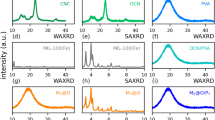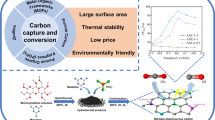Abstract
High CO2 concentration in atmosphere causes serious environmental issues, and carbon capture and storage technologies have attracted attention as a means to reduce the atmospheric CO2 concentration. Metal-organic frameworks (MOFs) can potentially be used for CO2 adsorption, but their poor stability and microporosity limit their applications. Herein, a novel strategy was proposed to combine a cellulose aerogel and hierarchically-porous MOFs (HP-MOFs) with larger pores. According to this strategy, a series of microcrystalline cellulose/HP-UIO-66-NH2 hybrid aerogels (MC-HUN-X) was constructed by adding a modulator (monocarboxylic acid, MA), followed by the in-situ growth of HP-UIO-66-NH2 on a cellulose aerogel. By adjusting the chain length of MA, the structure–function relationship between pore size and the CO2 adsorption capacity of MC-HUN-X was explored. The results showed that the CO2 adsorption capacity increased first and then decreased upon increasing the MOFs pore size, while the adsorption selectivity of CO2 continuously increased. Among all samples, MC-HUN-4 with a moderate pore size had the highest CO2 adsorption capacity (1.90 mmol/g at 298 K and 1 bar) and adsorption selectivity (13.02 and 2.40 for CO2/N2 and CO2/CH4). The combination with a cellulose aerogel endowed MC-HUN-X with excellent mechanical stability and reusability.
Graphical abstract
Cellulose/HP-UIO-66-NH2 hybrid aerogel with larger aperture sizes of MOF showed excellent adsorption capacity and selectivity for CO2, and the combination with aerogel could effectively improve the mechanical stability and reusability.










Similar content being viewed by others
References
Abdelhamid HN, Mathew AP (2022) Cellulose-metal organic frameworks (CelloMOFs) hybrid materials and their multifaceted applications: a review. Coordin Chem Rev 451:214263
Cai G, Jiang HL (2017) A modulator-induced defect-formation strategy to hierarchically porous metal-organic frameworks with high stability. Angew Chem Int Ed Engl 56:563–567
Cui J, Xu X, Yang L, Chen C, Qian J, Chen X, Sun D (2020) Soft foam-like UiO-66/Polydopamine/Bacterial cellulose composite for the removal of aspirin and tetracycline hydrochloride. Chem Eng J 395:125174
Darunte LA, Oetomo AD, Walton KS, Sholl DS, Jones CW (2016) Direct air capture of CO2 using amine functionalized MIL-101(Cr). ACS Sustain Chem Eng 4:5761–5768
Ding M, Flaig RW, Jiang HL, Yaghi OM (2019) Carbon capture and conversion using metal-organic frameworks and MOF-based materials. Chem Soc Rev 48:2783–2828
Falcaro P, Okada K, Hara T, Ikigaki K, Tokudome Y, Thornton AW, Hill AJ, Williams T, Doonan C, Takahashi M (2017) Centimetre-scale micropore alignment in oriented polycrystalline metal-organic framework films via heteroepitaxial growth. Nat Mater 16:342–348
French AD (2014) Idealized powder diffraction patterns for cellulose polymorphs. Cellulose 21:885–896
Gaillac R, Pullumbi P, Beyer KA, Chapman KW, Keen DA, Bennett TD, Coudert FX (2017) Liquid metal-organic frameworks. Nat Mater 16:1149–1154
Gao F, Li Y, Bian Z, Hu J, Liu H (2015) Dynamic hydrophobic hindrance effect of zeolite@zeolitic imidazolate framework composites for CO2 capture in the presence of water. J Mater Chem A 3:8091–8097
Ghanbari T, Abnisa F, Wan Daud WMA (2020) A review on production of metal organic frameworks (MOF) for CO2 adsorption. Sci Total Environ 707:135090
Jiang M, Li H, Zhou L, Xing R, Zhang J (2018) Hierarchically porous graphene/ZIF-8 hybrid aerogel: preparation, CO2 uptake capacity, and mechanical property. ACS Appl Mater Interfaces 10:827–834
Jiang X, Ren J, Kong Y, Zhao Z, Shen X, Fan M (2020) Shape-tailorable amine grafted silica aerogel microsphere for CO2 capture. Green Chem E 1:140–146
Kong Y, Jiang G, Wu Y, Cui S, Shen X (2016a) Amine hybrid aerogel for high-efficiency CO2 capture: effect of amine loading and CO2 concentration. Chem Eng J 306:362–368
Kong Y, Shen X, Fan M, Yang M, Cui S (2016b) Dynamic capture of low-concentration CO2 on amine hybrid silsesquioxane aerogel. Chem Eng J 283:1059–1068
Kronast A, Eckstein S, Altenbuchner PT, Hindelang K, Vagin SI, Rieger B (2016) Gated channels and selectivity tuning of CO2 over N2 sorption by post-synthetic modification of a UiO-66-type metal-organic framework. Chemistry 22:12800–12807
Lei C, Gao J, Ren W, Xie Y, Abdalkarim SYH, Wang S, Ni Q, Yao J (2019) Fabrication of metal-organic frameworks@cellulose aerogels composite materials for removal of heavy metal ions in water. Carbohydr Polym 205:35–41
Li D, Tian X, Wang Z, Guan Z, Li X, Qiao H, Ke H, Luo L, Wei Q (2020) Multifunctional adsorbent based on metal-organic framework modified bacterial cellulose/chitosan composite aerogel for high efficient removal of heavy metal ion and organic pollutant. Chem Eng J 383:123127
Li M, Liu Y, Li F, Shen C, Kaneti YV, Yamauchi Y, Yuliarto B, Chen B, Wang CC (2021) Defect-rich hierarchical porous UiO-66(Zr) for tunable phosphate removal. Environ Sci Technol 55:13209–13218
Liu N, Shi L, Meng X (2019) Tuning the adsorption properties of UiO-66 via acetic acid modulation. J Chem Sci 131:1–7
Lu W, Wei Z, Gu ZY, Liu TF, Park J, Tian J, Zhang M, Zhang Q, Gentle T, Bosch M, Zhou HC (2014) Tuning the structure and function of metal-organic frameworks via linker design. Chem Soc Rev 43:5561–5593
Ma X, Lou Y, Chen XB, Shi Z, Xu Y (2019a) Multifunctional flexible composite aerogels constructed through in-situ growth of metal-organic framework nanoparticles on bacterial cellulose. Chem Eng J 356:227–235
Ma S, Zhang M, Nie J, Tan J, Song S, Luo Y (2019b) Lightweight and porous cellulose-based foams with high loadings of zeolitic imidazolate frameworks-8 for adsorption applications. Carbohydr Polym 208:328–335
Mikkelsen M, Jørgensen M, Krebs FC (2010) The teraton challenge. A review of fixation and transformation of carbon dioxide. Energy Environ Sci 3:43–81
Millward AR, Yaghi OM (2005) Metal-organic frameworks with exceptionally high Capacity for storage of carbon dioxide at room temperature. J Am Chem Soc 127:17998–17999
Qiu J, Feng Y, Zhang X, Jia M, Yao J (2017) Acid-promoted synthesis of UiO-66 for highly selective adsorption of anionic dyes: adsorption performance and mechanisms. J Colloid Interface Sci 499:151–158
Ren W, Gao J, Lei C, Xie Y, Cai Y, Ni Q, Yao J (2018) Recyclable metal-organic framework/cellulose aerogels for activating peroxymonosulfate to degrade organic pollutants. Chem Eng J 349:766–774
Sanz-Perez ES, Murdock CR, Didas SA, Jones CW (2016) Direct capture of CO2 from ambient air. Chem Rev 116:11840–11876
Schaate A, Roy P, Godt A, Lippke J, Waltz F, Wiebcke M, Behrens P (2011) Modulated synthesis of Zr-based metal-organic frameworks: from nano to single crystals. Chem Eur J 17:6643–6651
Shang M, Zhang J, Liu X, Liu Y, Guo S, Yu S, Filatov S, Yi X (2021) N, S self-doped hollow-sphere porous carbon derived from puffball spores for high performance supercapacitors. Appl Surf Sci 542:148697
Sultan S, Abdelhamid HN, Zou X, Mathew AP (2019) CelloMOF: nanocellulose enabled 3D printing of metal-organic frameworks. Adv Funct Mater 29:1805372
Tao L, Lin CY, Dou S, Feng S, Chen D, Liu D, Huo J, Xia Z, Wang S (2017) Creating coordinatively unsaturated metal sites in metal-organic-frameworks as efficient electrocatalysts for the oxygen evolution reaction: Insights into the active centers. Nano Energy 41:417–425
Valencia L, Abdelhamid HN (2019) Nanocellulose leaf-like zeolitic imidazolate framework (ZIF-L) foams for selective capture of carbon dioxide. Carbohydr Polym 213:338–345
Wang Q, Luo J, Zhong Z, Borgna A (2011) CO2 capture by solid adsorbents and their applications: current status and new trends. Energy Environ Sci 4:42–55
Wang Z, Song L, Wang Y, Zhang XF, Hao D, Feng Y, Yao J (2019) Lightweight UiO-66/cellulose aerogels constructed through self-crosslinking strategy for adsorption applications. Chem Eng J 371:138–144
Wang C, Kim J, Tang J, Na J, Kang YM, Kim M, Lim H, Bando Y, Li J, Yamauchi Y (2020) Large-scale synthesis of MOF-derived superporous carbon aerogels with extraordinary adsorption capacity for organic solvents. Angew Chem Int Ed Engl 59:2066–2070
Wu H, Chua YS, Krungleviciute V, Tyagi M, Chen P, Yildirim T, Zhou W (2013) Unusual and highly tunable missing-linker defects in zirconium metal-organic framework UiO-66 and their important effects on gas adsorption. J Am Chem Soc 135:10525–10532
Wu HB, Wen X, Lou D (2017) Metal-organic frameworks and their derived materials for electrochemical energy storage and conversion: promises and challenges. Sci Adv 3:1–17
Wu T, Dong J, De France K, Zhang P, Zhao X, Zhang Q (2020) Porous carbon frameworks with high CO2 capture capacity derived from hierarchical polyimide/zeolitic imidazolate frameworks composite aerogels. Chem Eng J 395:124927
Xuan X, Wang M, Zhang M, Kaneti YV, Xu X, Sun X, Yamauchi Y (2022) Nanoarchitectonics of low-dimensional metal-organic frameworks toward photo/electrochemical CO2 reduction reactions. J CO2 Util 57:101883
Yang W, Han Y, Li C, Zhu L, Shi L, Tang W, Wang J, Yue T, Li Z (2019) Shapeable three-dimensional CMC aerogels decorated with Ni/Co-MOF for rapid and highly efficient tetracycline hydrochloride removal. Chem Eng J 375:122076
Zhang L, Zhao ZJ, Gong J (2017) Nanostructured materials for heterogeneous electrocatalytic CO2 reduction and their related reaction mechanisms. Angew Chem Int Ed 56:11326–11353
Zhao Y, Zhang Q, Li Y, Zhang R, Lu G (2017) Large-scale synthesis of monodisperse UiO-66 crystals with tunable sizes and missing linker defects via acid/base co-modulation. ACS Appl Mater Interfaces 9:15079–15085
Zhou HC, Kitagawa S (2014) Metal-organic frameworks (MOFs). Chem Soc Rev 43:5415–5418
Zhou HC, Long JR, Yaghi OM (2012) Introduction to metal-organic frameworks. Chem Rev 112:673–674
Zhu H, Yang X, Cranston ED, Zhu S (2016) Flexible and porous nanocellulose aerogels with high loadings of metal-organic-framework particles for separations applications. Adv Mater 28:7652–7765
Zhu L, Zong L, Wu X, Li M, Wang H, You J, Li C (2018) Shapeable fibrous aerogels of metal-organic-frameworks templated with nanocellulose for rapid and large-capacity adsorption. ACS Nano 12:4462–4468
Zhu W, Yao Y, Zhang Y, Jiang H, Wang Z, Chen W, Xue Y (2020) Preparation of an amine-modifified cellulose nanocrystal aerogel by chemical vapor deposition and its application in CO2 capture. Ind Eng Chem Res 59:16660–16668
Zong L, Yang Y, Yang H, Wu X (2020) Shapeable aerogels of metal-organic-frameworks supported by aramid nanofibrils for efficient adsorption and interception. ACS Appl Mater Interfaces 12:7295–7301
Funding
This work was supported by the Natural Science Foundation of Shandong Province (ZR2021QE252, ZR2019MEM034, ZR2021ME124, ZR2019PB029, ZR2020QE037), Postdoctoral Innovation Project of Shandong Province (202102060), Jinan High-end Talent Program (2019GXRC045), Key R&D project of Shandong Province (2019****0207), Science-Education-Industry Integration Innovation Pilot Project of Qilu University of Technology (2020KJC-GH13).
Author information
Authors and Affiliations
Corresponding author
Ethics declarations
Conflict of interest
The authors declare that they have no known competing financial interests or personal relationships that could have appeared to influence the work reported in this paper.
Additional information
Publisher's Note
Springer Nature remains neutral with regard to jurisdictional claims in published maps and institutional affiliations.
Supplementary Information
Below is the link to the electronic supplementary material.
Rights and permissions
About this article
Cite this article
Yu, S., Zhao, X., Zhang, J. et al. A novel combining strategy of cellulose aerogel and hierarchically porous metal organic frameworks (HP-MOFs) to improve the CO2 absorption performance. Cellulose 29, 6783–6796 (2022). https://doi.org/10.1007/s10570-022-04668-6
Received:
Accepted:
Published:
Issue Date:
DOI: https://doi.org/10.1007/s10570-022-04668-6




